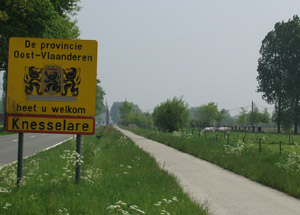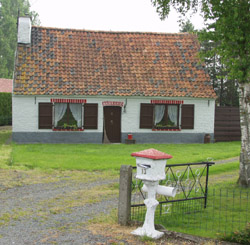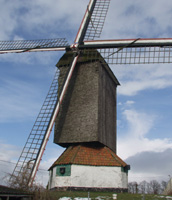The Meetjesland in the north of East-Flanders, Belgium

Knesselare
The name comes from the Germanic word "klisse" herb and "laar" or "leirs" which was a soggy brushwood terrain. The first time we find mention of the town in 1129 it was called Knislara. And then Kneslara, Cneslar and Clesselaer.
 |
"Welcome to the province of East-Flanders" |
Remains of the Bronze Age were found on what is now the sportsground. And in the Eendveldstraat there is a well dating from Roman times.
 During the Middle Ages Knesselare belonged to two important Seigneuries, i.e. the
Earldom of Knesselare and the "Land van de Woestijne" the Land of the
Desert. The Estate of the Princes, the court or "foncier" of the
Earldom can still be found on the Prinsenhofdreef, the Princes Court Drive, on the
border with Oedelem. Not far from there, in the Pilorijnstraat stood the
pillory of the Earldom.
During the Middle Ages Knesselare belonged to two important Seigneuries, i.e. the
Earldom of Knesselare and the "Land van de Woestijne" the Land of the
Desert. The Estate of the Princes, the court or "foncier" of the
Earldom can still be found on the Prinsenhofdreef, the Princes Court Drive, on the
border with Oedelem. Not far from there, in the Pilorijnstraat stood the
pillory of the Earldom.
The farm of the "Land van de Woestijne" (Land of the Desert) was situated just south of Knesselare on the territority of Aalter and north of the "Hoge Kale" or Durme.
In 1333 Lodewijk van Nevers (Louis de Nevere), count of Flanders, bought the Knesselare domain. In that same year he also bought the "Heintvelt" estate situated in "Clessenaer". About 1373 count Lodewijk van Male acquired from Wulfard van Borsele the Seigneury van de Woestijne. In 1379 he let this property to his bastard son Louis the Frisian whose descendants kept it till 1550. With the death of Louis van Praet in 1591 came an end to the line of descendants of Louis the Frisian.
 In 1566 there were in Knesselare a lot of adherents to the new religion called
Protestantism. They went to the chateau of Catharina van Boetzelaer at
Aalter to listen to the "geuzenpreken"
(Protestant Sermons) by preacher Pieter Carpentier. The widow of Jacob of
Flanders was a fervent follower of the new faith.
In 1566 there were in Knesselare a lot of adherents to the new religion called
Protestantism. They went to the chateau of Catharina van Boetzelaer at
Aalter to listen to the "geuzenpreken"
(Protestant Sermons) by preacher Pieter Carpentier. The widow of Jacob of
Flanders was a fervent follower of the new faith.
In 1583 the plague ravaged Knesselare and the rest of our Flanders. A third of the population died of it. Freeloaders, the protestants and the French sacked the town and set farms ablaze. The local population had fled and the town councellors had sought refuge at Bruges. None dared to come into the town except under the protection of soldiers.
After the beastly 16th Century came a period of slow recovery. In 1613 they started digging the Bruges Canal in the bed of the Zuidleie and Kale. The lord of the Land of the Woestijne started legal proceedings against the government claiming the right to levy a tax on every ship that passed through the canal.
In May 1642 the Spanish king, Phillip IV pawned the office of supreme justice for Ursel, Wessegem and Knesselare to Koenraad van Ursel, baron of Hoboken, and this to help defray the costs (500,000 guilder) of the army of Charles II, duke of Lorraine.
About 1641 the Seigneury of the Woestijne (Desert) came into the hands of Frederic Magnus Wildt and Rheingraaf, duke of Salms, lord of Geinstinghen, baron of Praet, Aalter, Beveren, Oedelem and Wijckhuizen. On 1 May 1647 he ordered Master Jacob Pecksteen to arrange for what in fact amounted to the merger of Knesselare, Aalter and Oedelem.
So many houses and farms in our regions went up in flames during the wars of Louis
XIV and that contrasts sharply with the period of relative calm and peace which was
the reign of Maria-Theresa from 1740 to 1780.
 In 1782 Willem Karel Gisleen, duke of Merode and of the Holy Roman Empire, marquess of
Westerlo was lord of Aalter, Knesselare and the
land of the Woestijne. He was the last lord of the Ancien Regime.
In 1782 Willem Karel Gisleen, duke of Merode and of the Holy Roman Empire, marquess of
Westerlo was lord of Aalter, Knesselare and the
land of the Woestijne. He was the last lord of the Ancien Regime.
Just before the Belgian independance Knesselare had 3853 inhabitants. There were two schools. Industrially things didn't look so bad: there were 4 windmills for wheat and one mill for oil. There was a paint factory, 3 genever distilleries, a starch factory and a blue factory. And the cloth weaving-mills employed 350 people.
From 1840 followed a period of great misery: it became ever more difficult for the cloth industry; harvests failed, the mechanization caused massive unemployment. Support came from Antwerp to help the poor of East-Flanders. Knesselare and Nazareth received 1500 francs each to alleviate the gravest need.
 |
Knesselare town is the owner of a lovely windmill, beautifully
restored and in good working order. Here is our page on Toatse Mill. |
 At the beginning of the
20th Century Mr. Van De Walle installed a cigar factory in Church Road. And here
starting in 1902 they made cigars i.a. the famous Cogetama cigar. It meant work
for many hundreds of local people. Until 30 June 1983 when the factory closed.
Now only the memories and the buildings remain.
At the beginning of the
20th Century Mr. Van De Walle installed a cigar factory in Church Road. And here
starting in 1902 they made cigars i.a. the famous Cogetama cigar. It meant work
for many hundreds of local people. Until 30 June 1983 when the factory closed.
Now only the memories and the buildings remain.
We want to be cristal clear about this politically uncorrect subject.
Lungs were designed for air and smoke. People have breathed in smoke around fires
for many many centuries. In the right dose so many things are beneficial.
That's even true for arsenic and... radiation. And the ideal dose is not zero.
There is no harm in a good cigar and a good whiskey or cognac. Too much is just simply
too much.
Should you, dear visitor, have more information about this factory, please
contact us. We know a book was written about it
and we would like to find someone willing to lend us his copy.
The source for much of the above is the excellent "Streekgids Meetjesland", 1998. See also: Our Sources.

More pictures
Our Meetjesland
— Table of Contents
— Find something in this Meetjesland website

MijnPlatteLand.com
Most recent update : 22-04-2021
Copyright Notice (c) 2025